NOTICE
Due to increased shipping prices, we regrettably can no longer cover costs to ship our trunks throughout the state. Trunks are available for local pick-up at no additional cost. If you choose to cover the shipping fee from OSA to your destination, we will invoice you for reimbursement. Current costs are in excess of $50 each way.
Formerly known as "Time Capsules from the Past," Discovery Trunks are comprehensive teaching resources created by OSA educators. Each Discovery Trunk helps educators tell unique stories about Iowa's past, using scientific inquiry, archaeology, history, and oral traditions, with themes ranging from Iowa's Ice Age to turn-of-the-century dairy farming. Lessons and hands-on activities (aimed at 4th-8th grade learners, but adaptable for all ages) are designed to match state curriculum priorities, such as the Iowa Core and National Science Education Standards, making them ideal teaching toolboxes ready to integrate with classroom activities.
The archaeology Discovery Trunks are used by K-12 educators, homeschooling groups, parents working with local AEAs, libraries, nature centers, and other groups engaged in educational programming. They each contain many objects, including authentic and replica archaeological artifacts, other scientific specimens, and high quality replicas of especially rare or fragile items. Books and background references for all ages and flash drives with digital content enhance the lessons. Each trunk has a particular theme and contains items specific to the time period/topic.
Explore Our Discovery Trunk Themes
Corn Farmers and Effigy Mound Builders: Iowa 1000 Years Ago
The Late Woodland archaeological time period (A.D. 300-1000) was one of remarkable change. The continent-wide exchange of exotic goods declined, but interaction between communities and regions continued and population levels apparently increased rapidly. In some parts of Iowa during the Late Woodland period, peoples aggregated into large, planned villages, but most of the settlements continued to be small and generally dispersed across the landscape. Bow and arrow technology arrived into the Midwest in the Late Woodland period. Continued native crop horticulture and diversified hunting and gathering provided the subsistence base through most of the period. Corn was introduced to many groups around A.D. 800, but it was not a staple crop until the Late Prehistoric archaeological time period. Late Woodland mound construction was generally simpler than in the Middle Woodland period, but regular aggregations for ritual and other purposes are reflected in hundreds of Late Woodland mound groups found throughout the state. Mound groups contain linear and conical mounds, as well as effigy mounds in the shapes of birds, bears, and more.
The archaeological term "Oneota" can be traced back to the early 1900s when Charles Keyes referred to ceramics found along the Upper Iowa River, formerly called the Oneota River, as Oneota. Most archaeologists now use Oneota to refer to several post-Woodland cultural groups living on the Prairie Peninsula that appeared about A.D. 1000 and continued there until the Historic period (ca. A.D. 1650). The Oneota cultural tradition is characterized by shell-tempered pottery, bone tools such as the bison scapula and deer mandible sickle; small, unnotched triangular arrow points; and village areas marked by an abundance of storage pits. Archaeological evidence for the Oneota cultural tradition shows a mixed economy with agricultural crops like maize, squash, and beans; plant gathering; and hunting for subsistence.
This Discovery Trunk captures this archaeological period of dynamic change and diverse resources with a variety of over 60 replica and authentic artifacts and samples. The resources provide educators and students with background information to enhance the learning experiences of both the provided and customizable lessons that can be adapted for K-12 audiences.
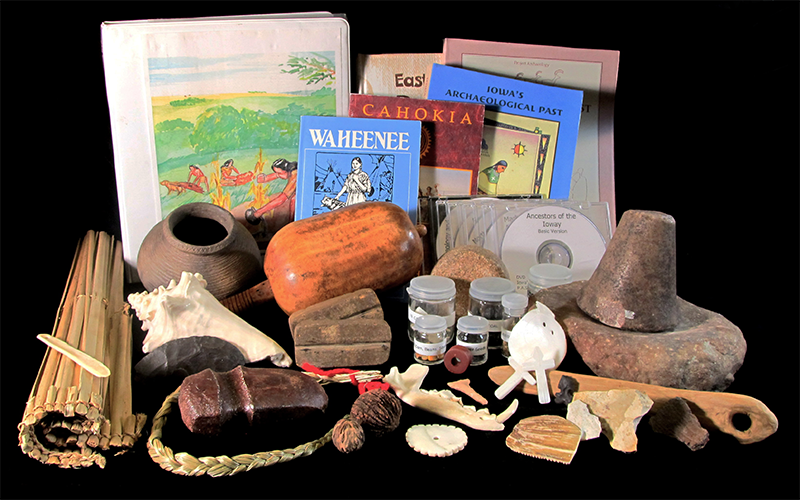
Dairy on the Prairie
Historic archaeology in Jones County tells the story of pioneer Iowa, particularly the rise of the dairy industry from the farm to the factory. Although we know a lot about this time period from history and written records, historic archaeology is still a very important supplemental tool for piecing together what we know about our historic past. While maps, deeds, newspapers, and census records may indicate the history of pioneer families, their professions, and their land transactions, archaeological clues help us to learn about the nature of their everyday lives, standard of living, and interactions with the outside world.
Contents of this Discovery Trunk include a sampling of the material culture of eastern Iowa pioneers between the 1830s and 1870s including: building and construction materials, household materials, glass and ceramics, plant and animal remains, and dairy items. Students love to explore the authentic historical artifacts from an archaeological excavation in Jones County. This trunk is also commonly used as a table-top exhibit to engage audiences in conversations about Iowa's pioneer and farming history.
Because objects such as the milking stool and butter churn do not fit in the trunk, these items cannot be shipped. They are available by request for pick-up/drop-off reservations.
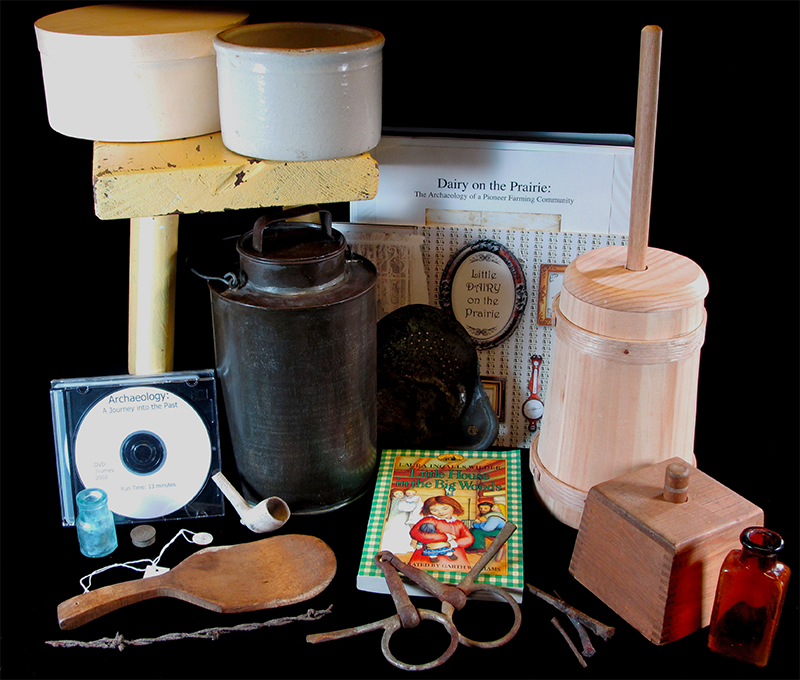
Early Farmers and Traders: Iowa 2000 Years Ago
The Middle Woodland period (100 B.C.-A.D. 300) in Iowa is noted for its refined artworks, complex mortuary program, and extensive trade networks linked with Hopewell centers in Illinois and Ohio. Hopewell network participants exchanged exotic raw materials such as Knife River flint from North Dakota, Gulf Coast marine shell, Great Lakes copper, mica from Appalachia, galena from the Dubuque and Galena localities, and several pipestones derived from Minnesota, Illinois, and Ohio. People during the Middle Woodland archaeological time period probably lived in small communities or farmsteads, focusing their subsistence economy on food resources in large river valleys and tending gardens of squash, tobacco, marshelder, and goosefoot.
This Discovery Trunk captures this archaeological period of early farming and trading with a variety of replica and authentic artifacts that demonstrate the technology of the time, such as spear points and chipped stone tools; an atlatl and replica spear; flint knapping tools; pottery-making tools and a replica Hopewell pot; seeds, nuts, and fibers; and a gourd rattle. Print and DVD resources provide educators and students with background information to enhance the learning experiences of both the provided and customizable lessons that can be adapted for K-12 audiences.
Because objects such as the replica spear (for show and tell only) or a modern throwing spear do not fit in the trunk, these items cannot be shipped. They are available by request for pick-up/drop-off reservations.
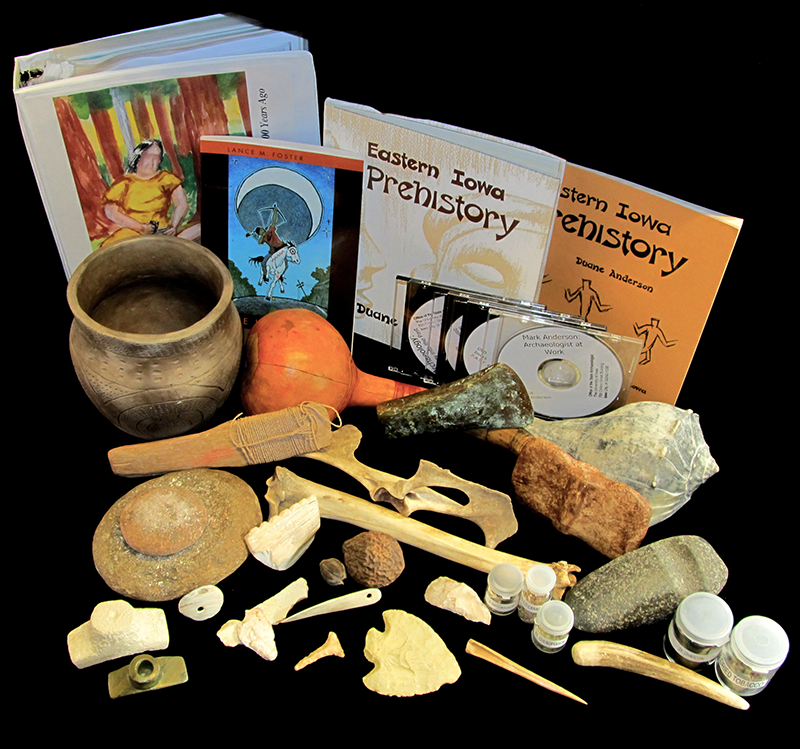
Exploring Glenwood Archaeology
Around A.D. 1,000 the climate was becoming warmer and more rainy, excellent for growing corn and other crops. People began to rely more and more on farming. The greater reliability of the food supply encouraged an increase in population. During the Plains Village period from about 1100 to 700 years ago, one of the cultural groups that lived in western Iowa was known as the Glenwood culture. Peoples lived in earthlodge settlements along the dramatic loess bluffs paralleling the Missouri River in southwestern Iowa and southeastern Nebraska. This location would have been particularly favorable to horticultural groups tilling the fertile, alluvial bottomland along the river. In general, they relied on farming but also continued to hunt, fish, and trap animals and to gather wild plants for many different uses.
The Plains Village traditions seem to have disappeared around A.D. 1400. The climate appears to have become hotter and dryer. These changes probably made it harder to grow crops in western Iowa. This, along with pressures from other groups in the surrounding areas may have eventually forced these villagers to move away. As they did, they probably met new people and environmental conditions that changed their lives and cultures.
Because objects such as the scapula hoe and cattail mat do not fit in the trunk, these items cannot be shipped. They are available by request for pick-up/drop-off reservations.

Fort Atkinson and the Neutral Ground, 1840-1849
The Fort Atkinson military post was established to help deal with some of the problems that resulted from the U.S. government’s Indian policy. It was the idea of Brigadier General Henry Atkinson who had promised to protect the Ho-Chunk (Winnebago) Nation from their enemies if they agreed to move from their traditional homeland in Wisconsin to the Neutral Ground in northeastern Iowa. Although no fighting ever took place at Fort Atkinson, General Atkinson carefully selected a site on a bluff overlooking Rogers Creek, a tributary to the Turkey River, that provided a good defensible position. Construction began in 1840. Fort Atkinson was manned until 1849 when the last Ho-Chunk were removed from Iowa to Minnesota. Archaeological research has been conducted at the site beginning as early as 1939. This work has recovered many artifacts associated with the occupation of the fort that provide a picture of what life was like there.
Resources in this Discovery Trunk highlight the culture and interaction of the groups associated with the occupation of Fort Atkinson and the Neutral Ground in northeastern Iowa in the 1840s: the soldiers, the Ho-Chunk (Winnebago) Indians, and the pioneer settlers. Contents include a sampling of artifacts used by each of these groups, lessons and activities, books, and period images. Of special interest are a journal written by a pioneer girl who lived in the area and a book detailing the childhood of a Ho-Chunk girl of about the same time period. The lessons and activities are designed to be compatible with social studies and history units on Iowa’s Peoples, Native People of Iowa, and the Westward Movement which are taught in the elementary grades in Iowa schools. The lessons also have strong science, language arts, and technology components.
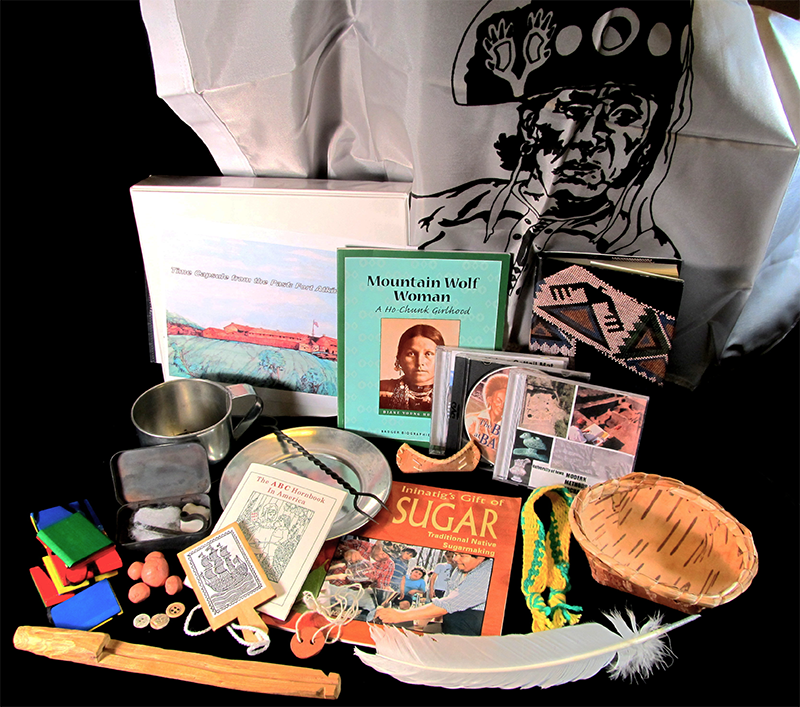
Fort Madison and the War of 1812
Fort Madison is one of the most important historic archaeological sites in Iowa. It was the first military fort that the United States government built in the Upper Mississippi River valley, and also the location of the only major battle of the War of 1812 that was fought west of the Mississippi River. In September of 1812, Black Hawk and his warriors attacked Fort Madison.
Fort Madison was burned to the ground by the army when it was abandoned in 1813. The area remained relatively isolated until Iowa was officially opened to settlers in 1832. In 1965, 152 years after the fort was burned, construction workers at the Shaffer Pen Company in the town of Fort Madison encountered a stone foundation underneath the company’s parking lot. Archaeological fieldwork took place in 1965, then again in 2009. The archaeologists learned a lot about how the fort was built. Artifacts from the excavation gave a glimpse into what life was like at the fort for soldiers, women, and children.
The trunk includes nearly 30 frontier-era replicas and reproductions, books and maps, an extensive background on archaeology and Fort Madison, as well as five lessons that focus on artifacts, maps and scales, context, and frontier life.

Iowa's Earliest Residents: 13,000-3,000 Years Ago
Iowa's original residents were small populations of hunters and gatherers distributed widely across a late Ice Age landscape. Then, the climate began warming, the sea level rose, and vegetation changed. People during the Paleoindian archaeological time period learned to adapt to this dynamic environment. They relied on species like the mammoth and mastodon, soon to become extinct. The Paleoindian period transitions into the Archaic period, where growing populations practiced new lifeways that incorporated modern types of plants and animals such as caribou, bison, small mammals, birds, fish, fruits, and nuts.
With this Discovery Trunk, your students can practice throwing spears* with a replica atlatl, just like Iowa's early hunters did! Replica mammoth and mastodon teeth are included, as are authentic fragments of megafaunal bones. Bison, bear, and rabbit track molds, a dog skull, and porcupine quills give students an idea of the animal resources of the time, while a replica Clovis point, fire-cracked rock cobbles, chert samples, and replica bone awl and needle give insight to the ingenuity of using and creating tools from available resources. Print resources help to customize lessons to suit multiple levels of students.
Because objects such as the replica spear (for show and tell only) or a modern throwing spear do not fit in the trunk, these items cannot be shipped. They are available by request for pick-up/drop-off reservations.

Meskwaki Culture and History
Historically, the Meskwaki were one of five or six politically allied Central Algonquian-speaking peoples that also included the Sauk, Miami, Kickapoo, Mascouten, and possibly Potawatomi. They were named “Renards” (Fox) by the French, who first encountered them in the Great Lakes region in the mid 1600s. Today, they identify themselves as Meskwaki, or “Red Earths.” Their migration to Wisconsin was related to the displacement of native peoples resulting from inter-tribal warfare in the Lower Great Lakes region and competition for the fur trade. Between 1712 and 1737, the French and Meskwaki engaged in an extended period of conflict known as the French and Fox Wars. By 1730, the Meskwaki were forced to abandon their east-central Wisconsin villages and migrate south and west. By 1800 they were firmly established in Iowa. Treated by the U.S. Government as a single “Sac and Fox Tribe,” the Meskwaki and the Sauk, lost all lands in Iowa through a series of treaty cessions. By 1845 most were removed to a reservation in east-central Kansas, although some Meskwaki remained hidden in Iowa and others soon returned. In 1856, the Iowa legislature enacted a law permitting the Meskwaki to remain in Iowa, and in 1857 they purchased the first 80 acres of their current Settlement in Tama County.
The Meskwaki were historically a semi-nomadic culture, electing to live together in a single concentrated area during the summer months but scattering into smaller, independent areas throughout the winter season. The Meskwaki economy combined hunting, gathering, and agriculture and did not depend on one means or another exclusively. Some other tribes were primarily agrarian or hunting-based and if those pursuits were threatened, their entire community life was compromised. By comparison, the Meskwaki were not totally dependent on one single way of making a living and were more flexible in adapting to sudden significant changes that so devastated many other tribes.
Resources in this Discovery Trunk highlight the changes in Meskwaki history and culture from time of Euro-American contact to the present. Students can explore items related to maple sugaring and play ancient games like as Double Ball.
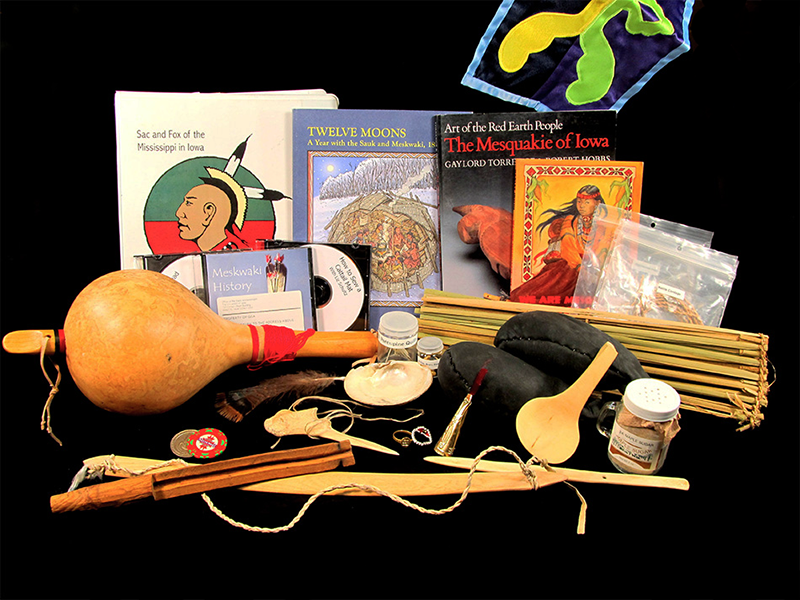
Reserve & Rent a Discovery Trunk
| rental logistics | |
|---|---|
| Service fee | A $25 service fee (per trunk) covers staff time to maintain the traveling trunk program, including processing requests, preparing trunks for shipping, inventorying and replacing items, and making upgrades to trunk contents and lessons; payable by cash or check |
| Shipping to you | Due to increased shipping prices, we regrettably can no longer cover this cost. If you choose to cover the shipping fee from OSA to your destination, we will invoice you for reimbursement. |
| Receiving a trunk | Trunks are available for local pick-up at no additional cost or shipped at the requestor's expense (see above). |
| Return shipping | It is your responsibility to pay for return shipping or drop-off the trunk to OSA during regular business hours. |
| Rental period | Maximum 30 days |
| Extensions | Negotiable at $10 per week beyond 30 days; dependent on other scheduled reservations |
| Late fees | $10 per week |